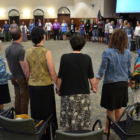
Trauma-informed Care in Juvenile Detention Is Not Enough
|
While Florida has taken steps toward integrating trauma-informed practices in the juvenile justice system, the state needs to reconsider its treatment of youth. Notably, utilizing trauma-informed care in the juvenile justice system, while necessary, is not sufficient — prevention should be the goal, with trauma-informed services implemented in all child-involved systems. The state must also stop incarcerating children with adults and offer all juveniles in detention/incarceration access to trauma-informed services.











